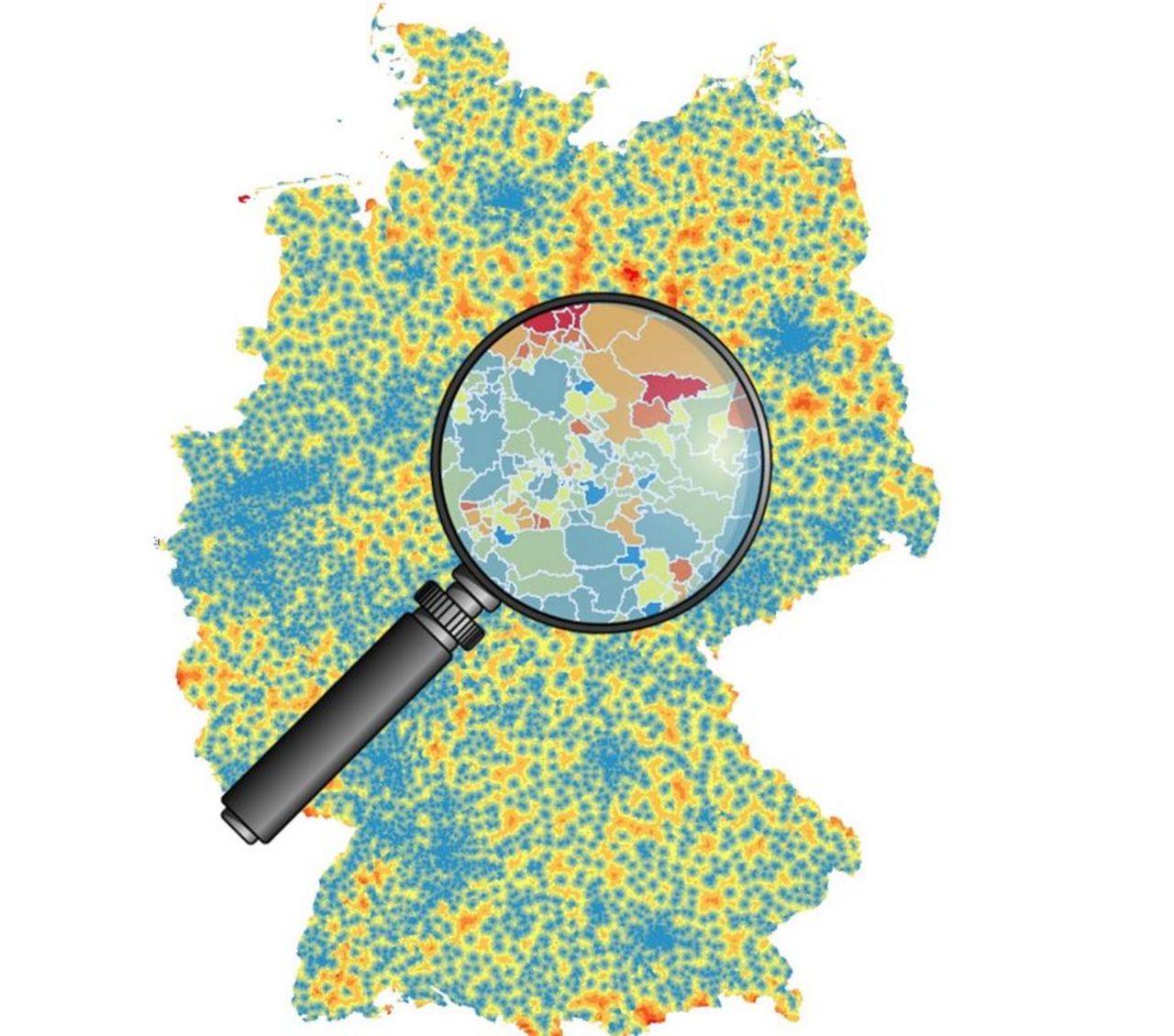Project
Monitoring of rural areas in Germany

Monitoring of rural areas in Germany: living conditions according to the official statistics and as perceived by the population
Rural areas might be differently delimited - depending on the specific definition of rurality applied. In our understanding, villages and small towns, a great share of agricultural land use and forestry, as well as a relatively low population, settlement and building density characterise rural areas. In the research project "Monitoring of rural areas" we developed our own delimitation. Accordingly, 57 per cent of the population of Germany (about 47 million people) live in rural areas that make up for 91 per cent of the entire territory. This delimitation is based on crucial structural and locational characteristics of rural areas and understands rurality as a morphological, functional and relational contiunuum (Küpper 2016).
Background and Objective
The official statistics already offer a wide range of data and indicators to analyse and depict living conditions in rural areas. Yet, rurality is characterized by highly diverse social, economic and structural conditions which so far can only hardly be portrayed. Neither an urban-rural dichotomy nor a rural-urban continuum are scientifically satisfactory concepts. Equally important is the fact that our knowledge on how the inhabitants of rural areas perceive and assess their quality of life and service provision – and whether distinct assessments coincide with different types of rural areas – is fairly limited. The monitoring project both provides a differentiated picture of rural areas in Germany and involves the perceptions of the population.
Approach
The monitoring of rural areas consists of five components:
1. a typology of rural areas to give consideration to the diversity of rurality in Germany (will be updated),
2. a continuously expanded set of indicators that allows for the analysis and illustration of social, demographic and economic developments of rural areas as well as their land use and service accessibility,
3. a web-mapping application (Landatlas) to display the different indicators by means of interactive maps,
4. standardized questionnaire surveys on subjective assessments of rural quality of life,
5. secondary analyses of large German population surveys (e.g. SOEP and ALLBUS)
Data and Methods
The monitoring builds, on the one hand, upon existing structural data that will be presented in interactive maps. To this end, we use small-scale data from official federal and state statistics (particularly the INKAR system of the Federal Institute for Research on Building, Urban Affairs and Spatial Development BBSR) and create new indices in order to display the social, demographic, economic and land-use situation of rural areas in Germany as well as its changes over time.
On the other hand, we create new data concerning the perceptions of rural living conditions by the population. To this end, in 2016 we conducted two standardised questionnaire surveys in rural areas in Germany. The first survey (general survey) focused on the quality of life and service provision as perceived by all population groups aged 18 years and older. It particularly considers issues of how to ensure a work-family balance. The second survey (in-depth survey) with the same thematic focus only addressed families with children younger than 13 years. This study is conducted in co-operation with the German Youth (DJI).
Our Research Questions
- How can we analytically and meaningfully classify rural areas in Germany?
- How do distinct types of rural areas differ with respect to their social, demographic and economic situation and in their land use?
- How does the population perceive the quality of life and provision of services in rural areas? Which problems and problematic areas can be identified? How are issues of the work-life balance perceived and assessed in different types of rural areas?
Preliminary Results
- In 2016, the new socio-spatial typology of rural areas was completed and published as a Thünen Working Paper.
- The web mapping application (Landatlas) which is continuously enlarged and updated is to be found here:https://www.landatlas.de/
- Results of the surveys with regard to the quality of life and work-life balance in different types of rural areas in Germany will be published in a Thünen Report.
Thünen-Contact

Involved Thünen-Partners
- Jetzkowitz, JensLV Institute of Rural Studies
- Keim-Klärner, SylviaLV Institute of Rural Studies
- Klärner, AndreasLV Institute of Rural Studies
- Kleiner, Tuuli-MarjaLV Institute of Rural Studies
- Knies, GundiLV Institute of Rural Studies
- Küpper, PatrickLV Institute of Rural Studies
- Neumeier, StefanLV Institute of Rural Studies
- Osigus, TorstenLV Institute of Rural Studies
Involved external Thünen-Partners
- Bundesinstitut für Bau-, Stadt- und Raumforschung (BBSR)
(Bonn, Deutschland)
Duration
Permanent task 7.2015
More Information
Project status:
ongoing
Publications to the project
- 0
Küpper P, Milbert A (2023) Typisierungen ländlicher Räume für Politik und Wissenschaft in Deutschland [online]. BBSR Online Publ 18/2023:9-24, zu finden in <https://www.bbsr.bund.de/BBSR/DE/veroeffentlichungen/bbsr-online/2023/bbsr-online-18-2023.html> [zitiert am 11.07.2023]
- 1
Neumeier S (2022) Accessibility of COVID-19 vaccination centers in Germany via different means of transport. KN J Cartogr Geogr Inf 72:41-58, DOI:10.1007/s42489-021-00088-x
- 2
Küpper P, Seel M (2022) Bewertung der Nahversorgung zwischen Treffpunktfunktion, Präferenzen, Ressourcen, Bewältigungsstrategien und räumlicher Nähe. DISP Planning Rev 58(2):56-73
- 3
Küpper P (2022) Raumtypisierungen am Beispiel der Thünen-Typologie. Landkreis Z Kommunale Selbstverwalt(1-2):14-17
- 4
Steinführer A (2021) Lässt sich die Zahl der Dörfer in Deutschland bestimmen? : Von Definitionsbemühungen, Suchwegen und unterschiedlichen Befunden. Ber Landwirtsch 99(3), DOI:10.12767/buel.v99i2.358
- 5
Kreis J (2021) Vorstellungen eines guten Lebens auf dem Land : Ergebnisse einer repräsentativen Befragung unter der Bevölkerung ländlicher Räume. Rurale Topografien 12:105-140, DOI:10.14361/9783839454251-003
- 6
Küpper P, Mettenberger T (2020) "Gehen oder Bleiben?" : Zufriedenheit junger Menschen mit den Lebensbedingungen in ländlichen Räumen. In: Farin K, Mey G (eds) Wir. Heimat - Land - Jugendkultur. Berlin: Hirnkost, pp 168-183
- 7
Steinführer A, Hundt C, Küpper P, Margarian A, Mehl P (2020) Gleichwertigkeit der Lebensverhältnisse - wissenschaftliche Verständnisse und Zugänge. Ländl Raum (ASG) 71(3):12-17
- 8
Küpper P, Milbert A (2020) Typen ländlicher Räume in Deutschland. Schrr Bundeszentrale Polit Bildung 10362:82-97
- 9
Deppisch L, Klärner A, Küpper P, Neumeier S, Osigus T (2020) Von der Erzählung vom "abgehängten ländlichen Raum" : Was uns ein Blick auf Strukturdaten verrät. Akt Analysen 76:40-51
- 10
Küpper P (2020) Was sind eigentlich ländliche Räume? [online] Inf Polit Bildung 343(2):4-7, zu finden in <https://www.bpb.de/izpb/laendliche-raeume-343/> [zitiert am 03.08.2020]
- 11
Küpper P, Peters JC (2019) Entwicklung regionaler Disparitäten hinsichtlich Wirtschaftskraft, sozialer Lage sowie Daseinsvorsorge und Infrastruktur in Deutschland und seinen ländlichen Räumen. Braunschweig: Johann Heinrich von Thünen-Institut, 168 p, Thünen Rep 66, DOI:10.3220/REP1547565802000
- 12
Möck M, Küpper P (2019) Polycentricity at its boundaries: consistent or ambiguous? European Planning Stud 28(4):830-849, DOI:10.1080/09654313.2019.1666802
- 13
Steinführer A (2019) Vom Altwerden in ländlichen Räumen: Strukturelle Rahmenbedingungen und individuelle Ressourcen der Alltagsbewältigung. Gesellsch Nachhaltigk 6:47-62
- 14
Osigus T, Neumeier S, Steinführer A, Küpper P, Kreis J (2018) Landatlas : ausgewählte Kartenbeispiele. Berlin: BMEL, 52 p
- 15
Steinführer A, Osigus T, Küpper P, Neumeier S, Kreis J (2018) Ländliche Räume im Fokus: der Landatlas als neue Informationsplattform. IÖR Schr 76:153-160
- 16
Born KM, Steinführer A (2018) Ländliche Räume: Definitionsprobleme, Herausforderungen und gesellschaftlicher Wandel. In: Stein M, Scherak L (eds) Kompendium Jugend im ländlichen Raum. Bad Heilbrunn: Verl Julius Klinkhardt, pp 17-44
- 17
Steinführer A (2018) Wohnen und Zuhause-Sein in ländlichen Räumen. Heimatbuch 65(2019):9-14
- 18
Küpper P (2017) Herausforderungen bei der Entwicklung ländlicher Räume - eine Bestandsaufnahme. Landkreis Z Kommunale Selbstverwalt(6):252-260
- 19
Steinführer A (2017) Vom Leben in Ländlichen Räumen. Materialiensamml Lehrstuhls Bodenordn Landentw Techn Univ München 49:14-18
- 20
Küpper P (2016) Abgrenzung und Typisierung ländlicher Räume. Braunschweig: Johann Heinrich von Thünen-Institut, 53 p, Thünen Working Paper 68, DOI:10.3220/WP1481532921000
- 21
Steinführer A, Osigus T, Küpper P, Neumeier S, Kreis J, Plankl R, Wolff M (2016) Landatlas 2016 : ausgewählte Kartenbeispiele. Berlin: BMEL, 45 p

![[Translate to English:] Logo des Bundesministerium für Ernährung und Landwirtschaft](/media/allgemein/logos/BMEL_Logo.svg)